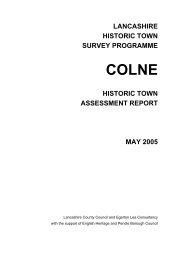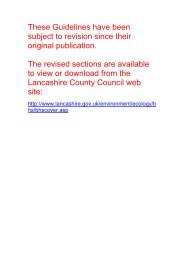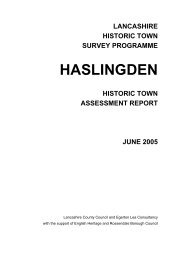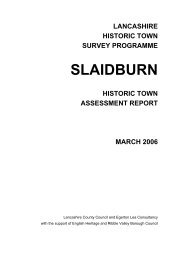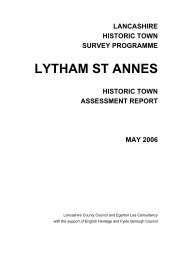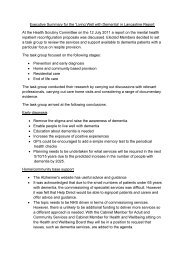HORNBY - Lancashire County Council
HORNBY - Lancashire County Council
HORNBY - Lancashire County Council
Create successful ePaper yourself
Turn your PDF publications into a flip-book with our unique Google optimized e-Paper software.
<strong>Lancashire</strong> Historic Town SurveyHornbySomerset. In addition the recent Cornwall Industrial Settlements Initiative has influencedthe approach, as many of <strong>Lancashire</strong>’s towns owe their urban origins to industrialisation.The <strong>Lancashire</strong> survey includes an additional aspect, however – urban characterisation.This specifically targets the broad archaeological and built heritage resource of thenineteenth-century industrial towns, a distinctive and significant feature of <strong>Lancashire</strong>’shistoric landscape. This aspect reflects the growing emphasis placed on characterisationfor managing change in both the rural and urban environments. It also reflects theimportance of local character in the definition of a sense of place, as emphasised in EnglishHeritage’s policy statement Power of Place (2000).The methodology adopted for the <strong>Lancashire</strong> project followed the three-stage process ofmany of its predecessors, comprising:• Stage 1 – Data-gathering• Stage 2 – Assessment• Stage 3 – Strategy.The data-gathering methodology involved historical research and a field visit. Mostinformation was entered directly into the <strong>Lancashire</strong> Historic Town Survey database, whichwas developed from existing databases. This was then used for analysis and, through theuse of the ArcView GIS program, for the production of coloured base maps showing sites,designations, development phases, historic plan components and character areas.The field visits examined the modern topography of each settlement, assessed likely areasof survival and destruction of deposits and structures, and created a basic photographicrecord in monochrome print and colour digital formats.The assessment stage tries to answer two broad questions: firstly ‘How has the settlementdeveloped over time?’ and secondly, ‘What is the physical evidence of the past in today’stownscape?’In answering the first question the assessment included a chronological appraisal of thedevelopment of each town under the following headings:• Prehistoric – up to cAD70• Romano-British – cAD70-400• Post-Roman and Early Medieval – 400-1050• Medieval – 1050-1550• Post-Medieval – 1550-1750• Industrial and Modern – 1750-presentThese chronological ‘snapshots’ or ‘timeslices’ (presented below in Section 4) offerdescriptions of settlement history that will include many buildings, structures and land usesthat no longer exist today, but which afford greater understanding of how the town hascome to look as it does. It is arranged from the perspective of the distant past lookingtowards the present.To answer the second question, ‘What is the physical evidence of the past in today’stownscape?’, the assessment stage included an appraisal of the surviving historiccharacter of each town. This effectively reverses the approach outlined above, to view atown from today’s perspective, but acknowledging the time-depth evident in the place. Forexample, the analysis does not attempt to reconstruct the medieval town, but instead mapsthe medieval elements (be they buildings, roads or other patterns) that survive in the townof today.© <strong>Lancashire</strong> <strong>County</strong> <strong>Council</strong> 2006 5



